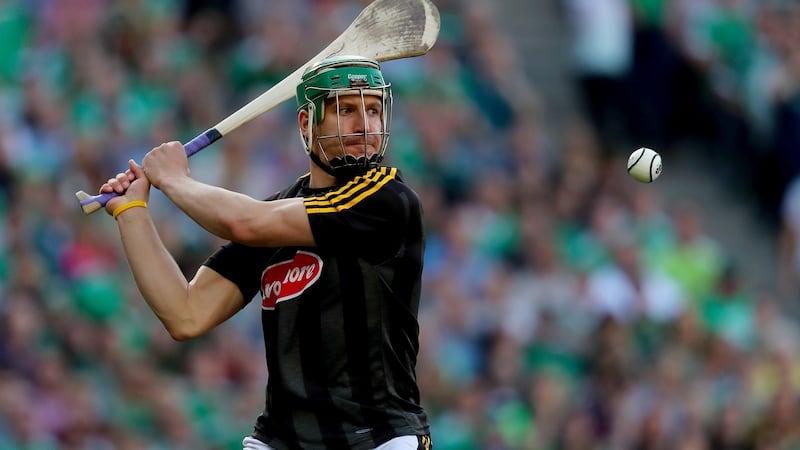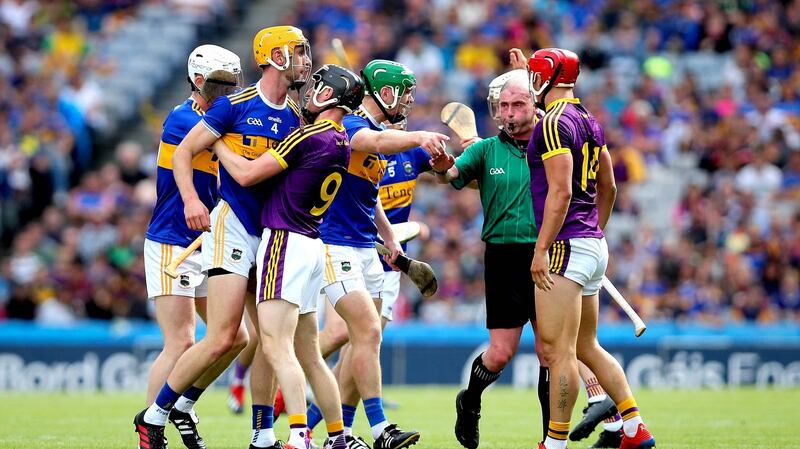Between now and Sunday week, Kilkenny and Tipperary will be analysed from thousands of angles by thousands of people with thousands of opinions. There'll be talk of match-ups, tactics, set-ups and all the rest of it.
Oddly enough though, the one thing people don’t tend to dwell on too much with these two teams in particular is puck-out strategies.
If Limerick were in the final or Cork or Clare or Wexford or nearly any team other than Tipp and Kilkenny, there'd be a big focus on each goalkeeper. What's each one's go-to puck-out? Who do they look for? What plays do they run to make space? But when Kilkenny and Tipperary meet, a lot of that talk kind of melts back into the background.
That is odd, when you think about it. Brian Hogan and Eoin Murphy will have somewhere between 30 and 40 puck-outs each on Sunday week. Both of them have had all year to work with management and with the outfield players on a definite, thought-through game plan. It's too big a part of the game now to just go out and belt away and hope for the best.
That said, it’s not hard to see why people would focus on other areas. Kilkenny and Tipperary would always have been pretty traditional when it comes to this stuff. I’m only retired a few years but, even in my time, it wasn’t as if we spent a lot of time coming up with elaborate schemes for puck-outs.
In fact, when I compare the Kilkenny teams that I played on to the way the game is now, it’s not just worlds apart – you’re talking about a different galaxy altogether. It’s so much more complex now, way more sophisticated. If a player from now was transported back a decade into the Kilkenny teams I played in, they’d nearly die of shock.
Here’s how we did puck-outs. I can sum it up in one simple action. PJ Ryan would pick up the ball to restart a game and look out the field for options and the first thing he would do would be to look at his full-back line. I never knew why he did that. Maybe it was just pure hope on his part. Whatever it was, it was a waste of time as none of us wanted the ball.
Michael Kavanagh was absolutely blatant about it. He would have his back turned to PJ and he may as well have had a Do Not Enter sign sellotaped across his jersey number.
I would expect this to be a final of long puck-outs aimed at a select group of receivers on either side
JJ Delaney would have a lukewarm body position, sort of half-turned and half-not. As if to say, “Here look, if you’re about to have a heart attack and you need to get rid of the ball, I suppose I may take it off you”.
As for me, I’d be turned facing PJ, kind of letting on that I was on for the short one but knowing I wasn’t really. I was like the kid in class with my arm half up in the air, on the basis that the teacher might see it and give me credit in his head for making the effort but really hoping to God that he didn’t come to me because I had no good answer for him.
Ultimate competitors
Even if PJ did hit me with it, there was only one predictable outcome from receiving the ball. In one swift rotating movement I would have launched it as far down the field as possible, swivelling off my left-hand side. I wouldn’t even have looked up the field to see who was available. When it eventually came down from the sky it would have had snow on it and it would have been up to the forward to fight for it then.
That was our attitude, simple and straightforward. Then again we were lucky, we were dropping bombs onto some of the greatest sky merchants in the game. Ultimate competitors and scavengers for the ball on the ground. Why wouldn’t you do that when the ball was landing on Eoin Larkin, Henry Shefflin, Martin Comerford, TJ Reid and Richie Power?
The God's honest truth is that puck-outs got the briefest mention imaginable when Brian Cody did his Friday night meeting before a game. We didn't waste very much time or energy or headspace on them. He would pick three lads in the half-forward line and tell the goalkeeper those were his puck-out options and then it would be on to the next thing.

I would suggest that has changed a lot these days. Fast forward 10 years and the time, energy, and resources going into puck-outs have multiplied 10 fold. It has happened everywhere and I don’t for one second think Brian and his management will deal with them puck-outs in just a single sentence over the coming nine days.
The interesting thing when you look at the puck-outs for both these teams, the fact that they both go as close to conventional as is possible these days means that their puck-out strategies are quite similar.
In general, they both go long most of the time. I would think that they will do this even more when they meet each other for the simple reason that neither of them will be coming up against a team that plays a spare man in defence.
When the opposition does that, it’s only natural Murphy or Hogan will the odd time take what’s offered to them and pick off an easy short one to their own spare man. And in this final, with half-forwards dropping back for both teams at puck-out time, you will occasionally have Paudie Maher or Pádraig Walsh left free. Hogan sometimes likes to pick out Noel McGrath dropping back to centre-back for a low lasered one as well.
But, for the most part, I would expect this to be a final of long puck-outs aimed at a select group of receivers on either side. For Kilkenny, TJ Reid and Walter Walsh will be the primary targets, with Adrian Mullen and John Donnelly expected to be in the mix as well. For Tipperary, it will be Niall O’Meara, Séamus Callanan and Dan McCormack.
All the talk in the build-up to the final will be about the intensity of the exchanges in and around the middle third. But in a way, that takes for granted that the two teams will more or less cancel each other out under the puck-outs. Whereas the reality is, if one side dominates the other’s puck-outs, then the battle in the middle third becomes less important. If you catch a puck-out, lay off a pass and your team-mates whips it over the bar, there’s no such thing as the battle for the middle third.
Deciding factor
I would expect there to be 50 to 55 long puck-outs next weekend. If one side more than breaks even over the other, that’s going to be nearly the biggest deciding factor in the game. It’s very possible that we could be sitting there on Sunday night week, picking out clips of the Mahers in the Tipp half-back line or TJ and Wally in the Kilkenny half-forwards and detailing how they won the game in the air.
It’s interesting to note that Colin Fennelly’s goal against Limerick came from a long puck-out from Eoin Murphy that landed on the 20-metre line. That was wind-assisted but it shows that Kilkenny have that option on the inside line as well as in the half-forward line.
For Tipp, I will be keen to see if they continue with Barry Heffernan instead of James Barry. For me, Barry is pound-for-pound a better close-quarters defender. Liam Sheedy could decide that this is going to be a particular type of game – long puck-outs, none of the running game that Wexford brought – and for that, a tight defender like James Barry could be the horses-for-courses choice.

But if you flip it around and look at it a different way, Heffernan is far more comfortable as an option for a short puck-out. He is happy to take the ball, break a tackle, connect with a support runner. Alternatively, if that short one goes to Paudie Maher, Heffernan will be all on for being that support runner himself.
In the semi-final, he made a few intelligent runs into the Wexford half and nearly looked like a forward himself at times. If for whatever reason Tipperary aren’t doing well under long puck-outs, they might start going short just to make sure of retaining possession and this could bring someone like Heffernan into the game big-time.
When you crunch the numbers and look at the long puck-out stats in both semi-finals, it’s very interesting. Kilkenny retained all of their six short puck-outs and Tipperary retained all four of theirs. Kilkenny went long 26 times and Tipperary long 25 times, so their numbers are very similar in terms of puck-outs taken long and short.
The main difference is Kilkenny had a 54 per cent retention rate when they went long and Tipperary had 44 per cent. That 10 per cent difference was TJ Reid who claimed puck-outs all over the Kilkenny attack. It was down the middle mainly but he likes to drift to the right and left wing at times so that he’s always asking different questions of the opposition defence.
Imperious form
Expect one of the three Mahers to be his shadow for the day. I would be surprised if it was anyone other than Brendan – Ronan Maher struggled aerially on TJ in the league final last year, and Paudie won’t leave the middle. Also, Brendan seems to be the guy who has been detailed to fire-fight for Tipperary this year, so we can expect him to be on TJ.
If either team’s analysis of the semi-finals counts for anything, we’ll see very little ball going down the middle. Kilkenny had huge success off their puck-outs against Limerick when they went to the wings, winning seven and five from either flank. Down the congested centre, they only won two puck-outs all day. They will try to isolate Mullen or Walter one-on-one and hit that area.
It was even worse for Tipp in their semi-final when they went down the centre. They only won one of five in that space and got eaten alive. With Pádraig Walsh in imperious form, you’d expect that down the middle of the Kilkenny defence will be a no-go area for Brian Hogan.
One way or the other, it’s going to be a crucial part of deciding who walks up the steps to pick up the trophy on Sunday week.












